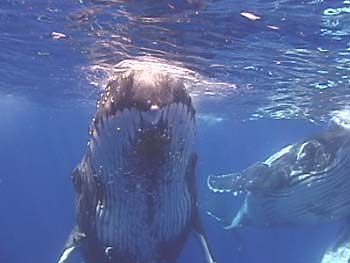 Humpback
whales, Megaptera novaeanglidae, migrate from their
feeding grounds in Antarctica, along the New Zealand coast,
to the Kindom of Tonga where they stay from July through
September to court, mate and calve. This "Tongan
tribe" is even more special than other groups of
humpbacks - the last to be hunted, the fewest survivors
and the least understood. Hunted until 1979 for their
oil, meat and bone, scientists now pursue humpbacks for
knowledge while travelers seek them for the thrill of
their lives.
Humpback
whales, Megaptera novaeanglidae, migrate from their
feeding grounds in Antarctica, along the New Zealand coast,
to the Kindom of Tonga where they stay from July through
September to court, mate and calve. This "Tongan
tribe" is even more special than other groups of
humpbacks - the last to be hunted, the fewest survivors
and the least understood. Hunted until 1979 for their
oil, meat and bone, scientists now pursue humpbacks for
knowledge while travelers seek them for the thrill of
their lives.
So named for the bump in front of their small dorsal fin, humpbacks are among the most energetic and inquisitive of the rorqual (or baleen) whales. Their complex and beautifully soulful songs have captured the attention of scientists and the imagination of the rest of us. Famous also for their spectacular habits of breaching, lobtailing, spyhopping and slapping their enormous pectoral fins, humpbacks are slow graceful swimmers, shallow distinctive divers who often show little fear of boats. Charming characteristics that have no doubt contributed to their endangered status. Antarctic humpbacks are typically darker on top than their northern cousins but boast brilliant white individually distinguishing patterns on their bellies and flanks as well as the undersides of their flukes and pectoral fins. Newborns (around 15 feet long!) are nursed closely by their mothers (adults reach 50 feet) for between one and three years before they embark on their own quest for a mate that takes them literally halfway around the world.
Until commercial whaling - and more recently large-scale illegal whaling from Soviet ships - devastated the species so effectively, southern ocean humpbacks wintered in Fiji as well as Tonga and were seen in groups as late as the 1960s. Recent investigations revealed that 48,477 South Pacific humpback whales were killed by the Soviet fleet alone between World War II and 1972, of which only 2,700 were reported. Many were killed even after humpbacks were granted full protection by the International Whaling Commission in 1962. One of the scientists working with the South Pacific Humpback Whale Project has discovered by DNA analysis that humpback whale meat is still being sold in Japan. Clearly humpback whales are not "saved".
In fact, a potentially powerful pro-whaling lobby group, the World Council of Whalers (WCW), was formed in January 1997. Council representatives from whaling industries in Japan, Iceland, Norway, Russia and the United States declared that the international organization was formed to promote whaling and oppose the anti-whaling movement. The WCW will have headquarters in Vancouver, BC, Canada, and was scheduled to hold its first meeting in November 1997 in Tonga! Why Tonga? Could it be that this is a sinister attempt to sell the concept of whaling humpbacks in Tonga's sheltered tropical breeding grounds to the government of this financially vulnerable and needy nation?
One thing is certain. The planet's quintessential symbol of conservation, the humpback whale - like all whales - needs protection more now than ever. To fight the whaling lobby and win, we must make whales more valuable alive than they are dead.
